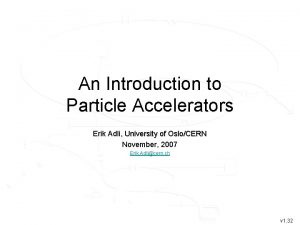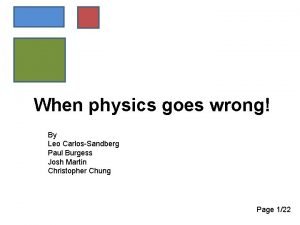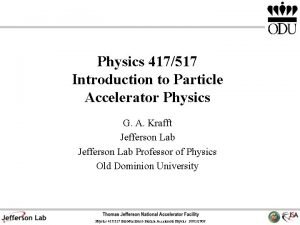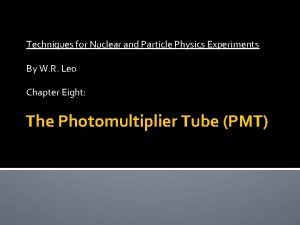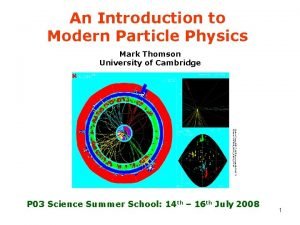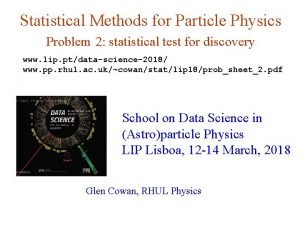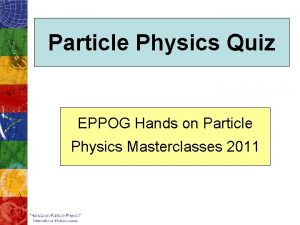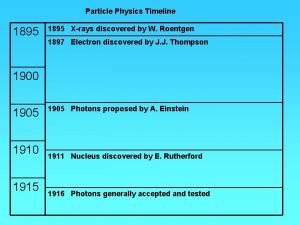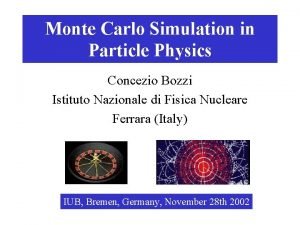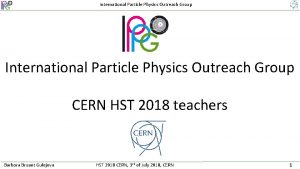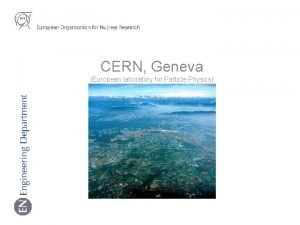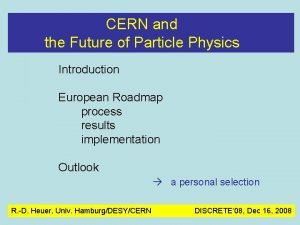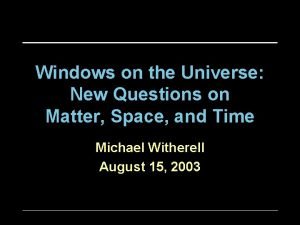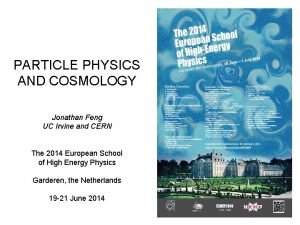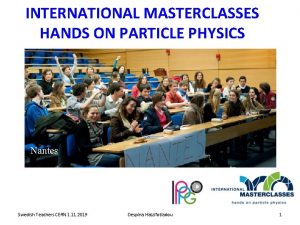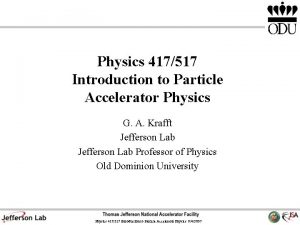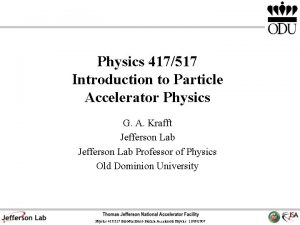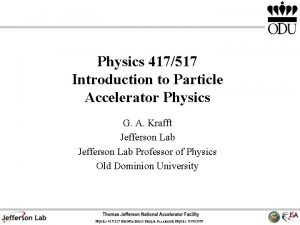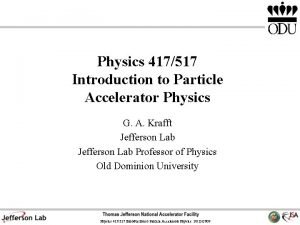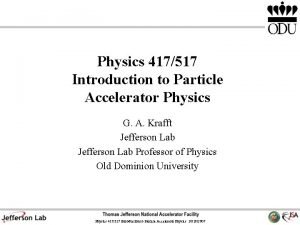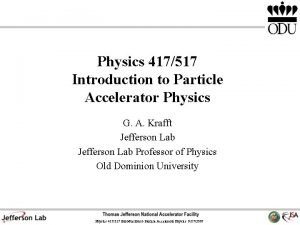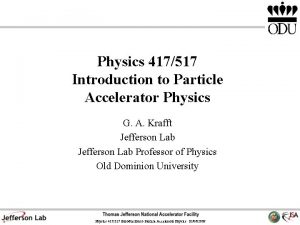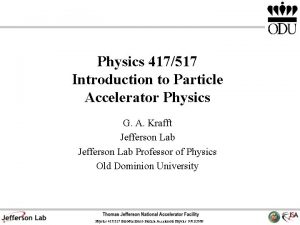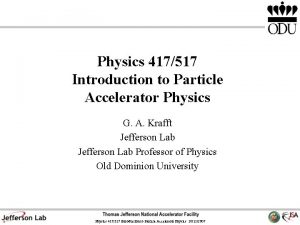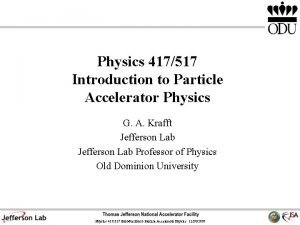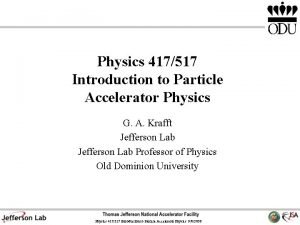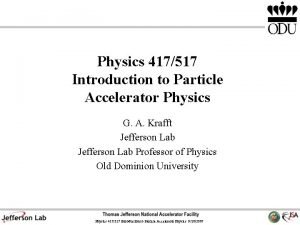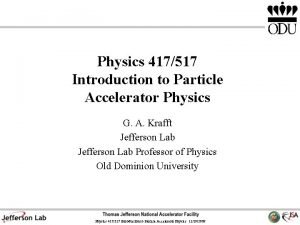Physics 417517 Introduction to Particle Accelerator Physics G















- Slides: 15

Physics 417/517 Introduction to Particle Accelerator Physics G. A. Krafft Jefferson Lab Professor of Physics Old Dominion University Physics 417/517 Introduction to Particle Accelerator Physics 10/16/2007

Pseudoharmonic Solution gives Using the x(s) equation above and the definition of ε, the solution may be written in the standard “pseudoharmonic” form The the origin of the terminology “phase advance” is now obvious. Physics 417/517 Introduction to Particle Accelerator Physics 10/16/2007

Case II: K(s) not periodic In a linac or a recirculating linac there is no closed orbit or natural machine periodicity. Designing the transverse optics consists of arranging a focusing lattice that assures the beam particles coming into the front end of the accelerator are accelerated (and sometimes decelerated!) with as small beam loss as is possible. Therefore, it is imperative to know the initial beam phase space injected into the accelerator, in addition to the transfer matrices of all the elements making up the focusing lattice of the machine. An initial ellipse, or a set of initial conditions that somehow bound the phase space of the injected beam, are tracked through the acceleration system element by element to determine the transmission of the beam through the accelerator. The designs are usually made up of wellunderstood “modules” that yield known and understood transverse beam optical properties. Physics 417/517 Introduction to Particle Accelerator Physics 10/16/2007

Definition of β function Now the pseudoharmonic solution applies even when K(s) is not periodic. Suppose there is an ellipse, the design injected ellipse, which tightly includes the phase space of the beam at injection to the accelerator. Let the ellipse parameters for this ellipse be α 0, β 0, and γ 0. A function β(s) is simply defined by the ellipse transformation rule where Physics 417/517 Introduction to Particle Accelerator Physics 10/16/2007

One might think to evaluate the phase advance by integrating the beta-function. Generally, it is far easier to evaluate the phase advance using the general formula, where β(s) and α(s) are the ellipse functions at the entrance of the region described by transport matrix Ms', s. Applied to the situation at hand yields Physics 417/517 Introduction to Particle Accelerator Physics 10/16/2007

Beam Matching Fundamentally, in circular accelerators beam matching is applied in order to guarantee that the beam envelope of the real accelerator beam does not depend on time. This requirement is one part of the definition of having a stable beam. With periodic boundary conditions, this means making beam density contours in phase space align with the invariant ellipses (in particular at the injection location!) given by the ellipse functions. Once the particles are on the invariant ellipses they stay there (in the linear approximation!), and the density is preserved because the single particle motion is around the invariant ellipses. In linacs and recirculating linacs, usually different purposes are to be achieved. If there are regions with periodic focusing lattices within the linacs, matching as above ensures that the beam Physics 417/517 Introduction to Particle Accelerator Physics 10/16/2007

envelope does not grow going down the lattice. Sometimes it is advantageous to have specific values of the ellipse functions at specific longitudinal locations. Other times, re/matching is done to preserve the beam envelopes of a good beam solution as changes in the lattice are made to achieve other purposes, e. g. changing the dispersion function or changing the chromaticity of regions where there are bends (see the next chapter for definitions). At a minimum, there is usually a matching done in the first parts of the injector, to take the phase space that is generated by the particle source, and change this phase space in a way towards agreement with the nominal transverse focusing design of the rest of the accelerator. The ellipse transformation formulas, solved by computer, are essential for performing this process. Physics 417/517 Introduction to Particle Accelerator Physics 10/16/2007

Dispersion Calculation Begin with the inhomogeneous Hill’s equation for the dispersion. Write the general solution to the inhomogeneous equation for the dispersion as before. Here Dp can be any particular solution. Suppose that the dispersion and it’s derivative are known at the location s 1, and we wish to determine their values at s 2. x 1 and x 2, because they are solutions to the homogeneous equations, must be transported by the transfer matrix solution Ms 2, s 1 already found. Physics 417/517 Introduction to Particle Accelerator Physics 10/16/2007

To build up the general solution, choose that particular solution of the inhomogeneous equation with boundary conditions Evaluate A and B by the requirement that the dispersion and it’s derivative have the proper value at s 1 (x 1 and x 2 need to be linearly independent!) Physics 417/517 Introduction to Particle Accelerator Physics 10/16/2007

3 by 3 Matrices for Dispersion Tracking Particular solutions to inhomogeneous equation for constant K and constant ρ and vanishing dispersion and derivative at s = 0 K<0 K=0 Dp, 0(s) D'p, 0(s) Physics 417/517 Introduction to Particle Accelerator Physics 10/16/2007 K>0

M 56 In addition to the transverse effects of the dispersion, there are important effects of the dispersion along the direction of motion. The primary effect is to change the time-ofarrival of the off-momentum particle compared to the on-momentum particle which traverses the design trajectory. Design Trajectory Dispersed Trajectory Physics 417/517 Introduction to Particle Accelerator Physics 10/16/2007

Classical Microtron: Veksler (1945) Extraction Magnetic Field RF Cavity Physics 417/517 Introduction to Particle Accelerator Physics 10/16/2007

Synchrotron Phase Stability Edwin Mc. Millan discovered phase stability independently of Veksler and used the idea to design first large electron synchrotron. Harmonic number: # of RF oscillations in a revolution Physics 417/517 Introduction to Particle Accelerator Physics 10/16/2007

Transition Energy Beam energy where speed increment effect balances path length change effect on accelerator revolution frequency. Revolution frequency independent of beam energy to linear order. We will calculate in a few weeks Below Transistion Energy: Particles arriving EARLY get less acceleration and speed increment, and arrive later, with repect to the center of the bunch, on the next pass. Applies to heavy particle synchrotrons during first part of acceleration when the beam is non-relativistic and accelerations still produce velocity changes. Above Transistion Energy: Particles arriving EARLY get more energy, have a longer path, and arrive later on the next pass. Applies for electron synchrotrons and heavy particle synchrotrons when approach relativistic velocities. As seen before, Microtrons operate here. Physics 417/517 Introduction to Particle Accelerator Physics 10/16/2007

Phase Stability Condition “Synchronous” electron has Difference equation for differences after passing through cavity pass l + 1: Because for an electron passing the cavity Physics 417/517 Introduction to Particle Accelerator Physics 10/16/2007
 Particle accelerator formula
Particle accelerator formula Medical particle accelerator
Medical particle accelerator Anatolij bugorski
Anatolij bugorski Particle accelerator
Particle accelerator Pmt particle physics
Pmt particle physics Modern particle physics mark thomson
Modern particle physics mark thomson Particle physics
Particle physics Particle physics practice quiz
Particle physics practice quiz Particle physics timeline
Particle physics timeline Monte carlo simulation particle physics
Monte carlo simulation particle physics Cern particle physics
Cern particle physics European laboratory for particle physics
European laboratory for particle physics Cern particle physics
Cern particle physics Particle physics
Particle physics Form factor particle physics
Form factor particle physics International masterclasses hands on particle physics
International masterclasses hands on particle physics
